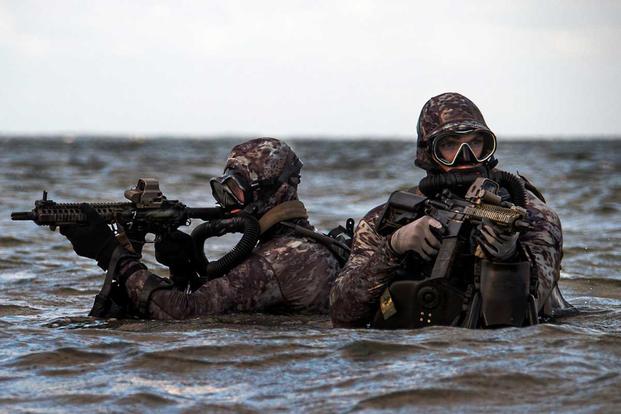A plan to boost the number of elite Navy SEAL platoons that could deploy across the globe remains in limbo months after the effort was halted by a string of high-profile scandals.
Naval Special Warfare Command has outlined some of the biggest organizational shifts to the SEAL community in decades, including a push to bump the number of platoons per team from seven to nine.
The plan was viewed as a positive step toward meeting the demands placed on the highly trained community. More platoons could deploy independently and offer more leadership positions across the force, Capt. Tamara Lawrence, a spokeswoman for the command, said.
But the effort was abruptly stopped this summer when Rear Adm. Collin Green, head of Naval Special Warfare Command, issued a four-page directive to his commanders calling for a return to good order and discipline for a community that had been making headlines for bad behavior.
The Navy SEALs would grow its number of SEAL platoons "ONLY AFTER we have groomed a sufficient inventory of leadership teams that have been adequately trained, certified and possess the highest standards of character and competence to fill the additional leadership positions in these tactical formations," Green said.
"We will only grow at the pace of excellence," he added.
Related: Head of Navy SEALs Says 'We Have a Problem' Following High-Profile Scandals
The number of Navy SEALs wouldn't change as a result of the new platoons, Lawrence said, since the planned nine would be smaller in size than the seven currently assigned to each team now. But the new platoons would create new leadership billets, she added. That's what Green wanted to examine.
"What Admiral Green was concerned about in the wake of some of the ethical lapses was that we need to make sure that we have the right bench to be able to fill those billets," she said. "[We] don't want to move people into a leadership position before they're ready."
Pausing the creation of new SEAL platoons was just one of the orders Green gave in his July letter. The letter ordered an end to what he called a "drift" away from good order and discipline.
A SEAL platoon had just been kicked out of Iraq over allegations of a sexual assault and drinking in the war zone. Several other SEALs had been booted out of the service for cocaine use and another was charged with spoofing someone online in an attempt to get nude photos. Eddie Gallagher had been found guilty at court-martial of wrongfully posing for a photo with a human casualty, and two other Navy special operators were brought to trial for their alleged connections in the death of an Army Green Beret.
In his memo to the command, Green said leadership is the solution to fixing the problems. Lawrence said working groups are meeting to determine when to proceed with creating the new platoons because both the "quantity and quality of leaders" has to be right.
Adding more SEAL platoons is part of the Naval Special Warfare Vision 2030, Force Optimization. Green told Defense Media Network in May that the realignments would help the SEALs counter new and existing threats.
"Vision 2030 sets NSW on a course to carry out our role in national defense, and will enable us to provide agile, lethal, and sustainable forces positioned to compete, disrupt, deter and win," he said.
-- Gina Harkins can be reached at gina.harkins@military.com. Follow her on Twitter @ginaaharkins.
Read More: Navy Eyes Move Away from Unpopular Unisex Uniforms














